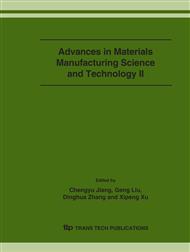p.829
p.833
p.837
p.841
p.845
p.849
p.853
p.857
p.861
Cutting Force Experiment and Simulation by Hard Turning GCr15 Bearing Steel with High Speed Considering Cutting Edge Preparation
Abstract:
In this study, hard turning GCr15 bearing steel with high cutting speed is experimental investigated the influence of the CB7015WH insert with chamfer edge and Safe-Lock and the CB7015 insert with a combination of hone radius and a chamfer edge on cutting forces and surface roughness of machined surface. Experimental results show that the cutting forces of the chamfer edge and Safe-Lock is smaller than that of the combination of hone radius and a chamfer edge. Moreover, surface roughness of machined surface with the CB7015WH insert is better. A coupled thermo-mechanical 2D finite element model with general finite element analysis software Deform 2D.8.1 is developed for the influence of two kinds of inserts on cutting forces and effective stress. The simulation results are compared with experimental data and found to be in good agreement.
Info:
Periodical:
Pages:
845-848
Citation:
Online since:
December 2006
Authors:
Price:
Сopyright:
© 2006 Trans Tech Publications Ltd. All Rights Reserved
Share:
Citation:


